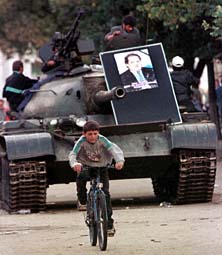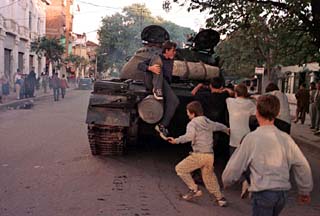

Occasionally gunfire erupts, long bursts of bullets streaming through the night, always night.
Men wearing blue fiberglass firemen’s helmets with Plexiglas face masks stand atop the two tanks--seized (captured? Perhaps handed over) from the national guard--manning heavy machine guns. The turret slowly rotates, and the main gun wheels upwards, pointing at a skyscraper not more than 30 meters away, still under construction, where, the rebels point out, they believe snipers are hiding. Some of the rebels are wearing tattered and ripped bulletproof vests. On both corners of the Democratic Party Headquarters (DP) there are bunkers made of sandbags, manned by kids with AK-47s. They stare down the street at the police forces opposing them. People stroll up and down one of the streets, crossing from one side to the other, into and out of no-man’s-land.
Outside the DP headquarters there are hundreds
of supporters, mostly men, but a few women as well, standing around waiting
for their hero, former President Sali Berisha, to return from a meeting
in a nearby hotel. When his Mercedes does pull up, he emerges brushing
back his mane of hair with the palm of his large hand, cheers erupt and
the crowd starts to chant.
 |
Former Albanian President Sali Berisha looks over the crowd at a rally outside of his Democratic Party headquarters in Tirana Wednesday Sept. 16, 1998. Photo by David Brauchli. |
Tension is in the air. The government, led by Socialist Prime Minister Fatos Nano, a former communist and political prisoner, has given the rebels at the DP until 1900 to hand over the tanks, or risk having the building stormed by heavily armed police units. Apparently, this is what Berisha’s earlier meeting had been about, because about 1825 one of the tanks roars to life, black smoke erupting out of the exhaust and blanketing those standing next to it. It starts off down the street in a cacophony of clanking diesel motor, and metal tracks grinding asphalt. The first tank wheels around the block to join the second tank, and is guided backwards into position. Berisha comes out onto the DP's balcony surrounded by photographers, television cameras and his goons. He addresses the few hundred faithful who have gathered. Berisha says rather than risk the lives of his supporters, he has agreed to hand back the tanks. Disappointment fills the air, tension eases like helium leaking out of a badly tied balloon. The working tank gives a pull on the parked tank, with a thick steel cable to jump start it, and they both go off down the street to a waiting police escort, back to where ever they sprung from before the violence.
Albania. I sing a song about it every time
I mention the word, mainly because my friend, Steph Heimann, taught me
a silly ditty last year before I was assigned to come here directly from
Hong Kong, and I can’t forget it for the life of me. Now, I sing it to
everyone else so they’ll think about the country the same way as I do--a
little crazy, a lot of fun and a great place to visit.
 |
 |
| Young Albanian boys run to catch a tank departing from a road in front of the Democratic Party headquarters in central Tirana Tuesday Sept. 15, 1998. Former President Sali Berisha's supporters rioted on the Albanian capitol's streets yesterday seizing tanks from the National Guard. Two tanks were returned to the government after it threatened to use all necessary force to remove armed men from around the building. (Photo by David Brauchli) |
Albania has had its share of problems:
occupation by the Turks for a few centuries, invasion by the Italians in
the Second World War, a corrupt and paranoid Communist dictatorship, starring
Enver Hoxa, and finally, the emergence of "democracy" after Hoxa’s successor,
Ramiz Alija, was cast out in 1991. Alija was succeeded by the populist,
Sali Berisha, who with his deep, gravelly voice, mane of graying hair,
and large stature, was able to convince, not only Albanians, but the West,
that change had truly come to Albania. The West believed him, poured
money into the country through the IMF and--poof-- things did start to
change. Buildings sprouted up overnight in Tirana, the capitol. Western
goods started to appear on the streets, restaurants opened, hotels were
built, and people started to live better. Mind you, it’s not hard to live
better when you’re starting with below zero.
 |
Supporters of former Albanian President Sali Berisha chant slogans outside of the Democratic Party headquarters in the Albanian capitol Tirana, Wednesday Sept. 16, 1998. Albania's parliament is looking to withdraw Berisha's parliamentary immunity to see if he and his top aides could be tried for trying to launch a coup earlier this week. (Photo by David Brauchli) |
But, Albania wasn’t immune to the scams of a few smart con men, and in 1995 a pyramid scheme was founded, and soon the majority of the people in the country had at least some of their savings in it. Surprise, surprise, it collapsed in early 1997. The government, unable or unwilling to pay people back the money they had lost, quickly became the target of demonstrations and riots. The people attacked government institutions, mainly the police and the army, until each abandoned their barracks and fled, leaving their arms caches wide open. It is estimated that over one million weapons were stolen during what is now referred to, here, as the "troubles."
President Berisha was largely blamed for the "troubles," and was forced into early elections. The election was contested in June, and Berisha was beaten by the Socialist candidate Fatos Nano, who promised, among other things, to pay Albanians back the money they had lost in the pyramid schemes. There was worry, for a time, that Berisha wouldn’t cede power peacefully, but he did, and Nano set up his government which was recognized and helped by the West.
So things puttered along in this little
Balkan country by the Adriatic. Investment came in dribs and drabs, mostly
from the Italians and Greeks. The OSCE and the EU kept an eye on matters,
and Nano did what he could to keep things stable with regards to the situation
on the northern frontier of the country--Kosovo. Just under three million
Albanians live in Albania proper, another two million live in Kosovo. Serbs
started early in 1998 to harass the people there, and the refugees started
coming over, not in the predicted streams, but so many that it worried
the international community, and strained the resources of the government.
Furthermore, the weapons which had been stolen during the "troubles" were
showing up in the hands of the Kosovo Liberation Army (KLA, or known more
commonly by their Albanian initials, UCK), and these guns were being run
into Kosovo by northern Mafia-types, who, more likely than not, were tied
to Sali Berisha, the former president.
| Contents
Page |
| Contents | Editorial | The Platypus | Links | Copyright |
| Past Features | Camera Corner | War Stories | Dirck's Gallery | Comments |
| Issue Archives | Columns | Forums | Mailing List |